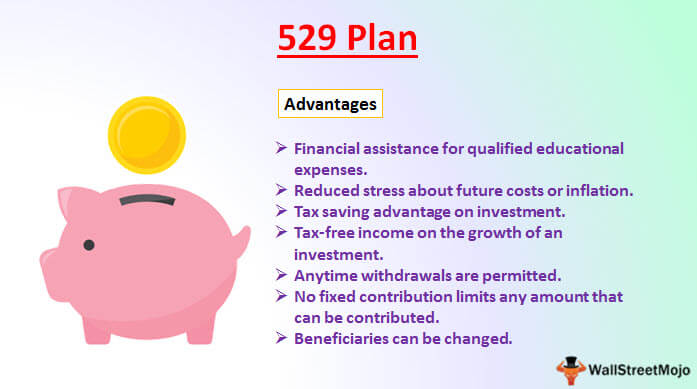An Overview to the 529 Plan Withdrawals for Private School
Dec 15, 2023 By Susan Kelly
Introduction
The amendments to the federal tax code that permit qualified withdrawals from 529 plans to pay for private high school and elementary school tuition apply to the entire United States. This means the federal tax treatment of 529 plans has shifted due to the 2018 tax legislation. This provision allows families to use up to $10,000 annually, per child, from a 529 plan to help pay for a private school in grades K-12. For federal income tax purposes, contributions are still not deductible; however, withdrawals used to pay for qualified higher education expenses or K-12 tuition are exempt from taxation.
529 Plan Rules
- All other rules about 529 plans remain in effect, except the annual $10,000 withdrawal limit for K-12 tuition expenses.
- The federal government does not recognize 529 plans as a tax deduction for annual contributions.
- Withdrawals from 529 plans for K-12 education above $10,000 or for non-qualifying expenses are subject to income tax and a 10% penalty.
- Contributions and gifts to a 529 plan that exceed the current IRS annual gift tax exclusion of $16,000 ($32,000 for couples) are subject to the federal gift tax.
You can contribute up to $80,000 (or $160,000 if you're contributing as a couple) in a year and have that amount "spread" out over five years. This allows you to use the gift tax exemptions for five years in a single year. If the donor survived for five years, this larger gift would not be subject to the gift tax. Due to the larger upfront gift and the subsequent removal of those assets from the donor's estate, this feature can be an effective strategy for long-term estate and gift planning.

Federal Tax Benefits
When money is taken out of a 529 plan and used for eligible education costs, neither the earnings growth nor the withdrawals are taxed. Qualified expenses were previously defined as only those connected with enrollment or attendance at a college, university, or other recognized postsecondary institution. Withdrawals for K-12 education costs up to $10,000 can now be made without penalty.
Private School Tuition Might be a State Tax Deduction
A tax credit or deduction is available for contributions to a 529 plan in more than 30 states. Families in Arizona, Kansas, Minnesota, Missouri, Montana, and Pennsylvania can take advantage of a tax deduction for contributions to any state's 529 plan. In contrast, residents must use their home state's plan in most other states. State limits are set for maximum deductions and credits.
Follow the 529 Withdrawal Rules Scrupulously
Adhering strictly to your 529 plan's guidelines is essential if you want to keep fees and taxes to a minimum. The general structure of a 529 plan is consistent across the country, but there may be minor variations in the details depending on where you live. That's why it's so important to play by the book, especially when making withdrawals. However, the rules have evolved over the past few years, increasing the occasions on which tax-free withdrawals are permitted. Earnings in a 529 plan are free from federal income tax "if distributed to a qualified educational institution and used for the qualified education expenses of the designated beneficiary," as defined by the Internal Revenue Service.
Parents Can Get Paid Too
Although 529 plans are most often used to reimburse students for eligible expenses, parents can also receive reimbursement in some cases. Indeed, this is yet another advantage of having a 529 plan. However, parents should take careful notes of their child's development. To have a distribution sent to a parent for qualified expenses paid for outside of a 529 plan, one must fill out a withdrawal form. But keep track of all of your receipts for those miscellaneous expenditures, and submit them with your distribution form.
Are Qualified Distributions for K-12 Tuition Expenses Taxable?
The federal government and the state of Maryland do not tax-qualified distributions used to pay for elementary, middle, and high school education. Since the tax treatment of K-12 distributions varies by state, you or your Beneficiary may be required to file and pay state income tax on the money received if you don't currently reside in Maryland. If you need help figuring out your taxes, talk to an expert.

Conclusion
You can use the money in your 529 plan for anything from elementary school to high school at a private school. Taxes on withdrawals are required or optional, depending on your financial situation and the state in which you reside. If you can afford college expenses on your own and can't name a different family member as the plan's Beneficiary, this may be a good option to consider.

Top 5 Most Effective Tips To Become a Freelancer
To have a complete say over one's working conditions is a tremendous perk of freelancing. If you're a freelancer, you can accomplish your job whenever and whenever you choose. Such allurement is a significant factor in the expansion of the freelance market. According to a recent survey on freelancing conducted by Upwork, upwards of a third of the American workforce is currently engaged in freelance work. But how can one begin a career in freelance work? You've reached the perfect spot if you want to start freelancing but don't know where to start. This post will look at the seven strategies you may use in 2022 to launch a successful freelancing career
Dec 14, 2023 Susan Kelly

What Are the 5 Potential Warnings About Index Funds?
Unsurprisingly, investors praise those who put money into index funds and exchange-traded funds (ETFs). When prices are low, and returns are high, index funds provide a convenient and inexpensive way for investors to track broad measures of the bond and stock markets. When compared to actively managed mutual funds, index funds often outperform them.
Oct 27, 2023 Triston Martin

Can You Please Calculate The Return Before Taxes
Regarding investment returns, "pretax" means that the return was determined before taxes were taken off. As everyone's tax situation is different and different assets are taxed at varying rates, the pretax rate of return is the most commonly cited metric for investments in the financial sector. Return on investment (ROI) after taxes is comparable to before taxes
Dec 21, 2023 Triston Martin

Secure Your Investments: A Simple Guide to Recession-Proof Stocks and Industries
Discover essential insights on recession-proof stocks and industries in this concise guide. Learn strategies to protect your investments.
Jan 15, 2024 Triston Martin

A Complete Guide to What Is Bank Credit?
A "bank credit" is a loan that a bank offers to its customers to meet their personal or business needs, with or without a guarantee or collateral, to earn a periodic interest rate on the loan amount. At the end of the loan term, the principal will be returned to you, as agreed upon and stated in the loan agreement.
Jan 08, 2024 Triston Martin

Bank Guarantee vs Letter of Credit: Understanding the Differences
Confused between Bank Guarantee (BG) and Letter of Credit (LC)? Read on to understand them, their features, and when to use them to secure transactions
Jan 17, 2024 Susan Kelly